General Information
Superoxide dismutase (SOD), which catalyzes the dismutation of the superoxide anion (O2.-) into hydrogen peroxide and molecular oxygen, is one of the most important antioxidative enzymes. In order to determine SOD activity, several direct and indirect methods have been developed. Among these methods, the indirect method using nitroblue tetrazolium (NBT) is commonly used due to the convenience and ease to use. However, there are several disadvantages in the NBT method, such as poor water solubility of the formazan dye and the interaction with the reduced form of xanthine oxidase.
SOD Assay Kit-WST allows very convenient SOD assay by utilizing Dojindo’s highly water-soluble tetrazolium salt, WST-1 (2-(4-Iodophenyl)- 3-(4-nitrophenyl)-5-(2,4-disulfophenyl)-2H-tetrazolium, monosodium salt) that produces a water-soluble formazan dye upon reduction with the superoxide anion. The rate of the reduction of WST-1 with O2.- are linearly related to the xanthine oxidase (XO) activity, and this reduction is inhibited by SOD, as shown in Fig. 1. Therefore, the IC50 (50% inhibition activity of SOD or SOD-like materials) can be determined by the colorimetric method (Patent filing).
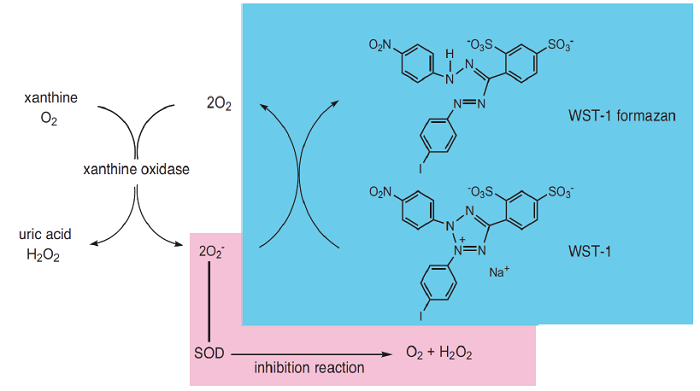
Fig.1 Principle of the determination of SOD activity using SOD Assay Kit - WST
Kit Contents
| WST solution | 5 ml x 1 |
| Buffer solution | 100 ml x 1 |
| Enzyme solution | 100 μl x 1 |
| Dilution buffer | 50 ml x 1 |
Storage Condition
Store at 0-5°C. Protect the WST solution and WST working solution from light.
Required Equipment and Materials
- Plate reader (450 nm filter)
- 2-20 μl and 20-200 μl pipettes, a multi channel pipette
- 96-well microplate
- Incubator
Precaution
- For dilution of sample, use Dilution buffer or saline.
- The Enzyme solution is separate into two layers. Therefore, omitting the pipetting process will result in inaccurate experimental results.
- For an accurate measurement, the use of multiple wells per sample is recommended.
- Since superoxide will be released immediately after the addition of Enzyme working solution to a well, use a multichannel pipette to avoid the reaction time lag of each well.
Sample preparation
General preparation methods are indicated in our home page. Access www.dojindo.com and go to SOD Assay Kit product information.
Preparation of Solutions
For one 96-well plate
WST working solution
Dilute 1 ml of WST solution with 19 ml of Buffer solution.
- WST working solution is stable for 2 months at 0-5 ℃.
Enzyme working solution
Centrifuge the Enzyme solution tube for 5 sec. Mix by pipetting, dilute 15 μl of Enzyme solution with 2.5 ml of Dilution buffer.
- Enzyme working solution is stable at 0-5 ℃ for 3 weeks.
Sample solution
Dilute sample solution with Dilution buffer or saline to prepare sample solution as follows.
Dilution ratio : 1, 1/5, 1/52, 1/53, 1/54, 1/55, 1/56
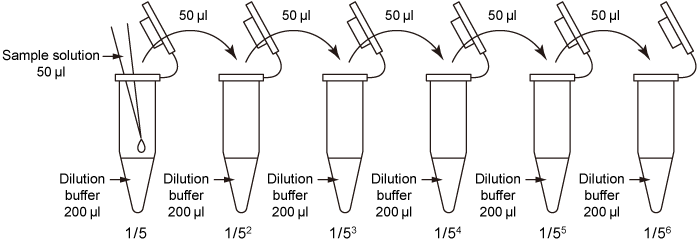
Fig. 2 Preparation of sample solution
| sample | blank1 | blank2 | blank3 | |
| Sample solution | 20 μl | - | 20 μl | - |
| ddH2O | - | 20 μl | - | 20 μl |
| WST working solution | 200 μl | 200 μl | 200 μl | 200 μl |
| Dilution buffer | - | - | 20 μl | 20 μl |
| Enzyme working solution | 20 μl | 20 μl | - | - |
blank 1 : coloring without inhibitor, blank 2 : sample blank, blank 3 : reagent blank
- If the color of the sample solution is strong, measure blank 2 at each dilution of the sample.
General Protocol
See Table 1, Fig.3 and 4.
- Add 20 μl of sample solution to each sample and blank 2 well, and add 20 μl of ddH2O (double distilled water) to each blank 1 and blank 3 well.
- Add 200 μl of WST working solution to each well, and mix.
- Add 20 μl of Dilution buffer to each blank 2 and blank 3 well.
- Add 20 μl of Enzyme working solution to each sample and blank 1 well, and then mix thoroughly.*
- Incubate the plate at 37℃ for 20 min.
- Read the absorbance at 450 nm using a microplate reader.
- Calculate the SOD activity (inhibition rate %) using the following equation.
SOD activity (inhibition rate %) = [(Ablank 1 - Ablank 3) – (Asample - Ablank 2)]/ (Ablank 1 - Ablank 3) x 100
- Since superoxide will be released immediately after the addition of Enzyme working solution to a well, use a multi-channel pipette to avoid the reaction time lag of each well.
Inhibition activity can also be determined by a kinetic method. Please determine an incubation time range that has a linearity of the slope before the assay. A good linearity should be observed up to 20 min. For the calculation, use the following equation:
SOD activity(Inhibition rate%) = [(S1 - S3) - (SS - S2)] / (S1 - S3) x 100
S1: slope of blank 1, S2: slope of blank 2, S3: slope of blank 3, SS: slope of sample
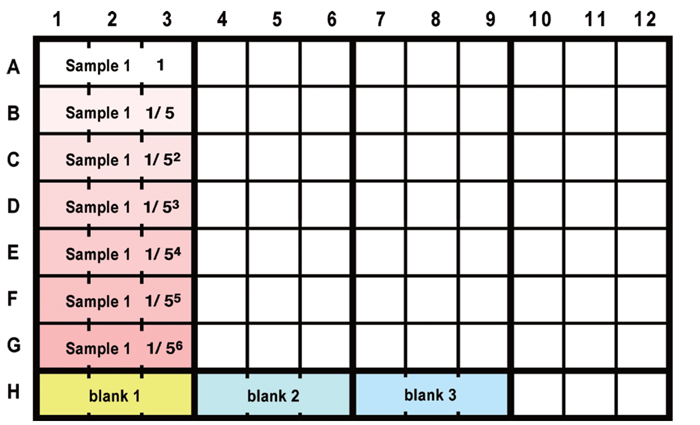
Fig.3 Example of sample and blank arrangement on a 96-well plate
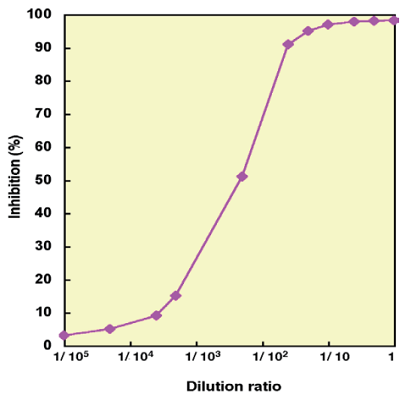
Fig.4 Inhibition Inhibition Curve curve of Cu, Zn-SOD
Definition of SOD Unit
『One unit of SOD is defined as the amount of the enzyme in 20 μl of sample solution that inhibits the reduction reaction of WST-1 with superoxide anion by 50%.』
Determination of SOD activity
- Read the dilution ratio at 50% inhibition (IC50) from inhibition curve.
- Multiply the dilution ratio at IC50 and at the sample preparation to obtain the SOD activity.
-
Example : Determination of SOD activity in erythrocytes
(The 1/108 diluted blood has been used as a sample solution.)- Read the dilution ratio at 50% inhibition (IC50) from the inhibition curve (Fig.5). The dilution ratio at IC50 is 1/1.8.
- The SOD activity before dilution is “1.8 U/20 μl ” from the definition above.
- The SOD activity in 1ml of sample is 1.8 / 0.02 = 90.0 U/ml.
- Multiply the SOD activity calculated above by the necessary dilution ratio for sample preparation. In the case blood is diluted to 1/108 during the sample preparation, the SOD activity in blood is calculated as below.
108 x 90.0 = 9,720 U/ml of blood
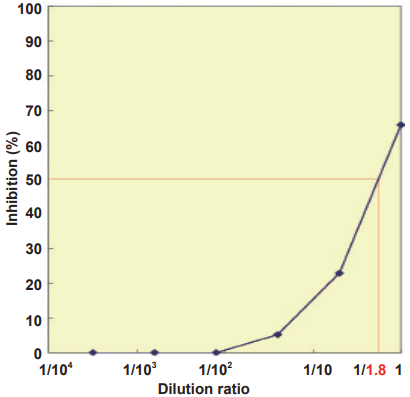
Fig.5 Inhibition curve of erythrocyte
Determination of Mn-SOD activity
Mn-SOD activity can be measured by adding potassium cyanide (final concentration: 1 mmol/l) or diethyldithiocarbamate (final concentration: 1 mmol/l) to the sample solution. These reagents inactivate Cu, Zn-SOD and extracellular-SOD activities.
Interference
Table 2 shows compatible concetration of possible interfering materials. If sample contains these materials, please dilute the sample to be below their compatible concentration.
Since 2-mercaptoethanol and dithiothreitol cause a significant increase of the O.D. value, please remove them when sample contains these materials.
| Detergents | Solvents | Reducing agents | others | ||||
| SDS | 0.05 % | Ethanol | 25 % |
Glutathione |
1.25 mmol/l | EDTA | 2 mmol/l |
| Tween 20 | 0.5 % | DMSO | 5 % | Ascorbic acid | 0.1 mmol/l | BSA | 1 % (w/v) |
| NP-40 | 0.5 % | ||||||
S311_500tests: SOD Assay Kit - WST (500 tests)
Revised Nov., 06, 2023


 Hidden sections will not be printed.
Hidden sections will not be printed.